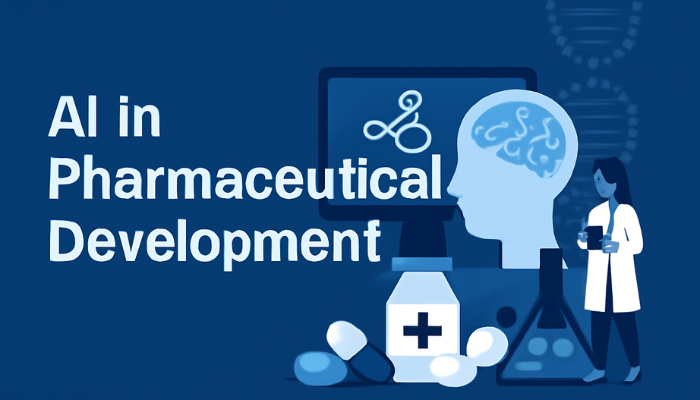Every day, businesses face a choice: embrace AI or risk falling behind. It’s no longer an abstract concept; AI is now a core driver of digital business transformation, enabling smarter decisions, better service, and more efficient operations. The question isn’t if you should adopt AI, but how quickly you can integrate it to stay competitive.
If you’re leading a business today, you’ve likely heard both hype and scepticism around AI. The truth lies somewhere in between. What’s clear is that companies strategically using AI are gaining a measurable edge. In fact, as of 2025, 78% of businesses have adopted AI, using it to improve customer service, streamline processes, and make faster, smarter decisions.
The conversation has shifted from “Should we use AI?” to “How do we implement it well?” But before diving into the how, let’s clarify what AI means in the context of digital transformation — and why it’s become essential for modern business.
What is AI in Digital Transformation?
When we talk about AI in digital transformation, we’re not referring to robots taking over your office. We’re talking about intelligent software that can analyze data, recognize patterns, and make decisions that traditionally required human judgment.
To see how traditional systems compare to AI-powered solutions, take a look at the table below. It highlights key differences in how each approach handles core business functions.
| Traditional Digital Systems | AI-Powered Systems |
| Follow pre-programmed rules and instructions | Learn from data and adapt behavior over time |
| Require manual updates and rule changes | Automatically improve performance through experience |
| Process information in fixed, predetermined ways | Recognize patterns and make contextual decisions |
| Need human intervention for exceptions | Handle variations and edge cases independently |
| Provide static reports and dashboards | Offer predictive insights and recommendations |
| React to events after they happen | Anticipate needs and proactively respond |
Digital transformation used to mean moving from paper to digital processes. Today, it means making those digital processes intelligent and responsive to changing business conditions.
Also Read: Examples of Successful Digital Transformation in Companies
Understanding these capabilities is important, but the real question for business leaders is: what tangible benefits can AI deliver to your organization and bottom line?
What are the Benefits of AI in Digital Transformation?
The real value of AI becomes clear when you look at how it impacts your day-to-day operations and long-term business goals. Here’s what you can expect when you integrate AI into your digital transformation strategy:
Immediate Operational Benefits:
- Faster Decision Making – Instead of waiting for monthly reports or spending days analyzing spreadsheets, AI processes vast amounts of data in minutes. For example, if you’re deciding whether to launch a new product line, AI can analyze market trends, competitor pricing, and customer sentiment from social media to give you a comprehensive analysis within hours rather than weeks.
- Reduced Operating Costs – AI handles routine tasks like invoice processing, appointment scheduling, and data entry that typically consume significant staff time. A mid-sized company often saves $50,000-$100,000 annually by automating these processes, allowing employees to focus on strategic work that directly impacts revenue.
- 24/7 Customer Support – AI-powered chatbots and virtual assistants handle common customer inquiries instantly, even outside business hours. This means your customers get immediate help with order tracking, product information, or basic troubleshooting, while your support team handles more complex issues that require human expertise.
- Improved Accuracy – Human error in data entry, calculations, and repetitive tasks can cost businesses significantly. AI eliminates these mistakes by processing information consistently every time. For instance, AI-powered inventory management prevents stockouts and overordering by accurately tracking demand patterns and supplier lead times.
Strategic Business Advantages:
- Competitive Intelligence – AI keeps a constant pulse on your industry, tracking competitor pricing changes, new product launches, and market trends. Instead of manually researching competitors or relying on outdated industry reports, you receive real-time alerts about market shifts that could affect your business strategy.
- Scalable Operations – As your business grows from 100 to 1,000 customers, traditional approaches require proportional increases in staff. AI systems handle increased workload without additional hiring costs. Your customer service AI can manage 10,000 inquiries as easily as 100, and your data analysis systems process larger datasets without slowing down.
- Personalized Customer Experiences – AI analyzes each customer’s purchase history, browsing behavior, and preferences to deliver tailored recommendations. This is like having a personal shopping assistant for every customer, resulting in higher conversion rates and increased average order values.
- Risk Management – Predictive analytics identify potential problems before they become costly issues. AI can predict which customers are likely to cancel their subscriptions, when equipment might fail, or if a supplier might face delivery delays, giving you time to take preventive action.
Financial Impact You Can Measure:
- Cost Reduction – Companies typically see 15-25% reduction in operational costs within the first year, translating to hundreds of thousands in savings for medium-sized businesses
- Revenue Growth – AI-driven personalization and optimization often increase sales by 10-20% through better customer targeting and pricing strategies.
- Efficiency Gains – Tasks that previously took hours now complete in minutes, allowing your team to handle 3-5 times more work without additional resources
- Customer Satisfaction – Response times drop from hours to seconds, and accuracy improves dramatically, leading to 20-30% higher customer satisfaction scores
The key is that AI doesn’t just make your current processes faster, it fundamentally changes what’s possible for your business. You can serve more customers, make better decisions, and respond to market changes with a speed and precision that wasn’t achievable before.
But implementing AI successfully requires more than just choosing the right technology. Let’s explore the practical steps you need to take to make AI work for your specific business situation.
How to Implement AI in Your Business: A Practical Approach
Moving from understanding AI benefits to actually implementing it in your business requires a structured approach. Many companies rush into AI adoption without proper planning, leading to failed projects and wasted resources.
Here’s a step-by-step guide to help you implement AI successfully.
Step 1: Assess Your Current Business Situation
- Identify Pain Points – Start by listing your biggest operational challenges. Are you spending too much time on manual data entry? Do customers complain about slow response times? Are you struggling to predict inventory needs? These problems are often perfect candidates for AI solutions.
- Evaluate Your Data – AI needs quality data to function effectively. Review what data you currently collect, how it’s stored, and whether it’s accurate and complete. If you’re tracking customer interactions, sales patterns, or operational metrics, you likely have enough data to start with AI applications.
- Check Your Technology Infrastructure – Assess whether your current systems can support AI tools. Most modern AI solutions work with standard business software, but you’ll need reliable internet connectivity and adequate data storage capabilities.
- Determine Your Budget – AI implementation costs vary widely. Simple chatbots might cost $500-$2,000 monthly, while comprehensive AI systems can require $10,000-$50,000 initial investment. Set realistic expectations based on your available resources.
Step 2: Start Small and Focused
- Choose One Specific Problem – Don’t try to revolutionize your entire business at once. Pick one area where AI can make an immediate impact. For example, start with customer service automation or sales lead scoring rather than attempting to automate your entire supply chain.
- Pilot Projects Work Best – Run a 3-6 month pilot program with a limited scope. This allows you to test AI effectiveness, learn what works, and refine your approach before expanding to other areas.
- Set Clear Success Metrics – Define exactly what success looks like. If you’re implementing AI for customer service, measure response times, customer satisfaction scores, and resolution rates. Having specific numbers helps you evaluate whether the AI is delivering value.
Step 3: Build Your AI Team
- Identify Internal Champions – Find employees who are excited about AI and can help drive adoption. These don’t need to be technical experts, but they should understand your business processes and be willing to learn new systems.
- Partner with Experts – Unless you have significant technical expertise in-house, consider working with AI consultants or development companies. They can help you avoid common pitfalls and implement solutions more quickly.
- Train Your Staff – Prepare your team for changes in their daily work. Provide training on new AI tools and help them understand how AI will enhance rather than replace their roles.
Step 4: Implementation and Testing
- Start with Proof of Concept – Before full deployment, create a small-scale version of your AI solution. Test it with a limited number of customers or on a subset of your data to identify any issues.
- Monitor Performance Closely – Track your AI system’s performance daily during the first few weeks. Look for accuracy issues, user complaints, or unexpected behaviors that need adjustment.
- Gather Feedback – Collect input from employees using the AI system and customers affected by it. Their insights often reveal improvement opportunities that aren’t obvious from performance metrics alone.
- Iterate and Improve – AI systems improve over time, but they need guidance. Regularly review results, update training data, and refine system parameters based on real-world performance.
Step 5: Scale Successful Solutions
- Expand Gradually – Once your pilot project proves successful, gradually expand to other areas of your business. Use lessons learned from your initial implementation to avoid repeating mistakes.
- Integrate with Existing Systems – Ensure your AI solutions work smoothly with your current business software. Data should flow seamlessly between systems without requiring manual intervention.
- Plan for Growth – Choose AI solutions that can scale with your business. What works for 100 customers should also work for 1,000 customers without major overhauls.
Common Implementation Mistakes to Avoid:
- Expecting Immediate Perfection – AI systems need time to learn and improve. Don’t abandon a solution if it’s not perfect on day one.
- Ignoring Data Quality – Poor data leads to poor AI performance. Invest time in cleaning and organizing your data before implementing AI solutions.
- Underestimating Change Management – Your team needs time to adapt to new ways of working. Provide adequate training and support during the transition.
- Starting with Complex AI Solutions: Jumping into advanced AI can overwhelm your team. Focus on simple tasks like automation or data accuracy first to build a strong foundation.
The key to successful AI implementation is patience and persistence. Companies that approach AI strategically, starting small and building on successes, typically see better results than those trying to implement everything at once.
Struggling with data integration for AI implementation?
At Codewave, we can overcome this by using advanced machine learning, sensor fusion, and real-time data processing, enabling seamless AI integration with existing systems.
Also Read: How to Select the Right Digital Transformation Company for Your Business
Now that you understand the implementation process, let’s look at some real-world examples of businesses that have successfully integrated AI into their operations.
5 Examples of AI-Influenced Digital Transformation
Here are five practical ways AI is changing how businesses operate and serve their customers, with real examples you can learn from and potentially implement in your organization.
1. Conversational AI for Better Customer Service
Modern AI customer service goes far beyond simple chatbots that frustrate customers with robotic responses. Today’s conversational AI understands context, handles complex inquiries, and provides personalized assistance.
How It Works in Practice:
- Basic Level – FAQ bots that understand natural language questions and provide relevant answers from your knowledge base, handling routine inquiries automatically
- Advanced Level – Virtual assistants like those used by major banks that can check account balances, transfer funds, and even help customers apply for loans through natural conversation
- Sophisticated Level – AI systems that recognize customer emotions, escalate complex issues to human agents with full conversation context, and learn from each interaction to improve future responses.
Business Impact: Companies using advanced conversational AI see significant reductions in customer service costs while dramatically improving response times. Your customers get help when they need it, and your team focuses on complex issues that require human expertise.
2. AI-Powered CRM Systems for Better Customer Relationships
AI transforms customer relationship management from a data storage system into an intelligent business advisor that helps you understand and serve customers better.
What AI-Enhanced CRM Does:
- Customer Intelligence – Combines data from website visits, purchase history, social media interactions, and support tickets to create complete customer profiles
- Predictive Analytics – Identifies which customers are likely to make large purchases, which might cancel their subscriptions, and what products they’re most interested in
- Automated Insights – Alerts your sales team when a customer shows buying signals or when it’s the optimal time to reach out with specific offers
Real Business Examples:
- Salesforce Einstein helps sales teams prioritize leads by predicting which prospects are most likely to convert, improving close rates significantly
- Zoho CRM’s AI assistant automatically logs customer interactions, suggests next steps, and identifies the best times to contact each prospect.
- HubSpot’s AI tools analyze customer behavior to recommend personalized content and optimal communication timing.
3. Intelligent Inventory and Supply Chain Management
AI revolutionizes how businesses manage inventory, predict demand, and optimize their supply chains, moving from reactive to proactive management.
How AI Transforms Inventory Management:
- Demand Forecasting – Analyzes historical sales, seasonal trends, economic indicators, and even weather patterns to predict future demand accurately
- Automated Reordering – Places orders automatically based on predicted demand, supplier lead times, and optimal stock levels
- Supply Chain Optimization – Identifies potential disruptions before they happen and suggests alternative suppliers or shipping routes
Business Success Stories:
- Amazon’s AI system manages millions of products across global warehouses, predicting demand so accurately they can ship items before customers order them in some cases
- Walmart uses AI to optimize inventory levels across thousands of stores, reducing stockouts while decreasing overall inventory costs
- OTTO Group (major European retailer) uses machine learning to predict future purchases with high accuracy, allowing them to optimize stock levels and reduce storage costs
4. Personalized Marketing and Customer Experience
AI enables businesses to treat each customer as an individual, delivering personalized experiences that were previously impossible at scale.
Personalization in Action:
- Dynamic Content – Website content, email campaigns, and product recommendations automatically adjust based on each visitor’s behavior and preferences
- Behavioral Targeting – AI analyzes how customers interact with your brand across all touchpoints to predict their interests and optimal engagement timing
- Predictive Customer Journey – Maps individual customer paths and identifies the best moments to present offers, content, or support
Measurable Results:
- Netflix’s recommendation engine drives the majority of viewer engagement, keeping customers subscribed longer and reducing content acquisition costs
- Amazon’s personalization contributes significantly to their total revenue through targeted recommendations and personalized shopping experiences
- Spotify’s AI creates personalized playlists that increase user engagement and reduce subscription cancellations
5. Intelligent Business Process Automation
AI-powered automation goes beyond simple rule-based tasks to handle complex business processes that require decision-making and judgment.
Advanced Automation Examples:
- Invoice Processing – AI reads invoices from different suppliers, extracts relevant information, matches them with purchase orders, and flags discrepancies for human review
- Hiring and Recruitment – AI screens resumes, schedules interviews, and even conducts initial candidate assessments, dramatically reducing hiring time
- Financial Analysis – AI analyzes financial data, identifies trends, creates reports, and alerts management to potential issues or opportunities
Real-World Implementation:
- JP Morgan’s AI system processes legal documents in seconds that previously took lawyers thousands of hours annually.
- Unilever uses AI for initial candidate screening, processing millions of applications annually while reducing bias and improving candidate quality.
- Maersk employs AI for logistics optimization, automatically routing shipments and predicting delays, improving efficiency significantly.
Also Read: Steps for Successful AI Implementation Strategy in Your Business
Ready to Transform Your Business with AI?
Seeing these success stories might leave you wondering: “How can my business achieve similar results?” The challenge isn’t knowing that AI can help, it’s knowing where to start and how to implement it correctly. Thats where Codewave comes in.
Common Pain Points We Help Solve:
- We don’t know which AI solution fits our business– You’ve seen the possibilities but struggle to identify which AI applications would deliver the most value for your specific operations and goals
- Our team lacks the technical expertise– Your staff understands your business perfectly but doesn’t have the AI development skills to build and implement intelligent solutions.
- We’ve tried AI before and it didn’t work– Previous attempts with basic chatbots or simple automation tools left you disappointed and skeptical about AI’s real potential.
- We’re worried about disrupting our current operations– You want AI benefits but can’t afford downtime or operational disruptions during implementation.
How Codewave Solves These Challenges:
- Strategic AI Consulting – We start by understanding your business processes, identifying specific pain points, and recommending AI solutions that deliver measurable ROI. Our design-thinking approach ensures every AI implementation solves real problems.
- Custom AI Development – Using technologies like TensorFlow, PyTorch, and cloud-based AI services from AWS and Google Cloud, we build customized solutions that integrate seamlessly with your existing systems.
- End-to-End Implementation – From initial consultation to deployment and ongoing support, we handle the entire AI development lifecycle. Your team focuses on running the business while we handle the technical complexity.
- Proven Methodology – With over 250 successful digital transformation projects across 15 countries, we’ve developed proven frameworks for AI implementation that minimize risk and maximize results.
Your Next Step:
Don’t let your competitors gain the AI advantage while you’re still planning. Schedule a consultation with our AI experts to discuss your specific business challenges and leverage AI for digital transformation.
Codewave is a UX first design thinking & digital transformation services company, designing & engineering innovative mobile apps, cloud, & edge solutions.







